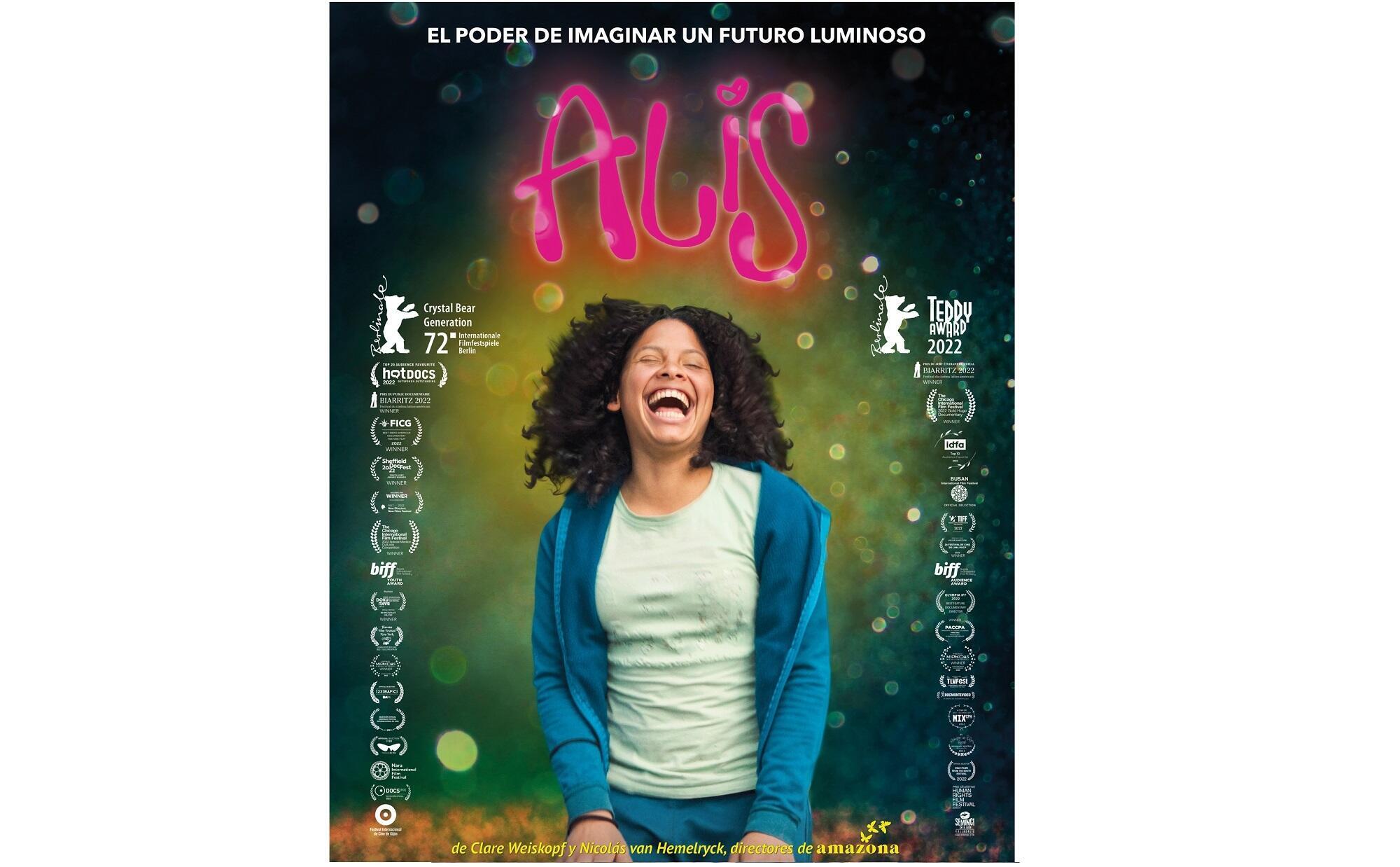Laureate of 22 awards, including the Crystal Bear and the Teddy Award at the Berlinale, the Young Jury Award at the Biarritz Festival and the Audience Award for El Perro que Ladra in Paris, the Colombian film Alis premiered on Wednesday, January 25 in France. Radio France International spoke with its director, Nicolás Van Hemelryck.
The documentary surprises and moves. To begin with, for its austere and audacious format: a close-up or medium shot of a girl, filmed with a single camera and a single lens, while she narrates stories of an imaginary friend. Because of the excellence with which these stories are interwoven and because of the place where the stories come from: a suis-generis hostel that welcomes young adolescents in conditions of enormous vulnerability, forced to leave their homes and fall into ruin, misery and the violence offered by life in the streets of the Colombian capital.
RFI: How was Alis?
Nicholas Van Hemelryck: The genesis of the film, its origin, was a documentary film workshop that we were invited to give at that center and when they told us who we were going to give the workshop to, we felt sorry. We have two little daughters and imagining these abandoned girls made us feel that. But, when we got to know the young women, we realized that this pity was our prejudice, that it was not something that was in them, but in whoever looks at them. They aroused our admiration and in them we find strength, resilience, humor, innocence. And that’s when we decided we wanted to make a movie. And what the film wants is to look them in the eye because they have always been denied, made invisible. It is a population that makes people feel uncomfortable. So we wanted the viewer to have to watch and listen to them during the hour and a half that the film lasts.

RFI: You talk about Clare, who is your life partner, because she is your life partner, the mother of your daughters and the cinematographic universe they share. We don’t see Clare in the film, but we know of her resounding presence because of that degree of confidence that the girls have a secret in her. How did you guys come to achieve that rapport? whatWas it a crush or is this a long love story with those girls?
NVH: It was a crush at the beginning, in 2016, in that first workshop. It was a short workshop, two weeks, and then we wanted to come back because it was as enriching for them as it was for us to be there. So, they spent five years there, building trust not only with the institution, but with the young people. What is felt in the film is only possible because of the long relationship we have with them.
Full interview in audio version:
Nicolas Van Hemelryck, filmmaker, RFI guest
Nicolas Van Hemelrick, filmmaker, RFI guest
RFI: Where did the idea of telling the story of these girls come from through an imaginary friend that they invent and in which they invest their lives, it would be said, in a kind of reincarnation?
NVH: The idea of imagination comes from them. It’s not something we decide, and what if… right? One of the many exercises we did in the workshops studying storytelling was to write a story for the next class. We told them bring a story that has a new beginning and an outcome. What you want. And those stories, even though they were full of fantasy, and that began in other worlds -there were some that began in Paris, for example- very quickly reflected their universes, their family relationships, their dreams, their fears, their traumas. We heard the stories and we were shocked. And we were wondering how to go about exploring that in the film. It was later, with more development, that we began to work on our imagination. At the Center there are always girls who leave, who run away: ‘And Laura? Well, she ran away or the family came and took her away. So we thought that it could be done as one of them, a presence that is there. And then, then it’s not there anymore.
RFI: From individual stories, from the stories of multiple personal violence that these girls narrate, one can intuit a much more universal reality of marginality. How long did the filming of these stories last and how were they filmed, by theme or in one shot with each girl?
NVH: The shooting time was two weeks, which is impressive for a documentary film. Normally documentary filming lasts many years. We didn’t want to go out to record without knowing what we were looking for, so it took five years of development to really get to know them, get to know their universe, the institution and understand what we wanted to convey with that film and, later, how to do it. For this, the work with the two editors, with the scriptwriter and with the whole team was very important. They were involved from the development.
When we started filming we didn’t know what Alis we were going to find, but we did know that they have the talent to create a moving story. And we already had a possible structure written that we wanted the film to convey. What happened during the investigation is that when we asked them to tell us what Alis is like and we asked her how you met her, what she was like. “Well, fat, short. And I met her at the boarding school and I asked her why she was here with her and she told me that because… ” and right there they entered dark history. So, the research material was a very hard and very dark material. And they are not just that. The importance of the structure was to look for that light that they also have, how to talk about other things, how to bring humor, how to build something that starts out very light and very naive and little by little takes you into a much deeper world. The questions we wrote also followed that structure. But, in the meetings, the questions became more flexible, because if a girl continues to speak on one side and one sticks only to the script, well, she is taking her out of the story all the time. And Clare is a great interviewer. What she does with them is a masterful thing.

The assembly was weaving and finding in a sea of material at those moments and knowing where to put what, how to generate contrasts, how to generate surprises, how to generate mystery, laughter, tears. When they came to meet us in their bedroom, they knew they were coming to a recording of a conversation, but they didn’t know what was going to happen. They were unique encounters and, as in the film, where it is stated at the beginning that we are going to do an exercise: ‘close your eyes’. That was the setup. We wanted to be very transparent in the assembly of this, it happened like this: they come in, they sit down and we propose something to them. They were meetings between 20 and 60 minutes with each one. They are a bit boring, conversations where not so much happens. There is not the tension that is felt in the film. That is already assembly work.
RFI: The soul of the documentary is funny and sensual, and one of the daring themes, like all those addressed in Alis, is sexuality. For example, they assume they are boys, they use masculine names, they dress in men’s clothing. Alis does not have a defined gender, says one of the young women when she describes her imaginary friend. They tell Clare about her love and sexual relationships that they have imagined those daily lives. whatIs sexuality at the Center that natural?
NVH: The institution is impressive. It is the most tolerant place for adolescents that I have known in Colombia. It is surprising because Colombia, being such a conservative society and so intolerant in that sense, in this place everything is accepted and not questioned. There we met in these five years trans men, trans women, that is, all the genders that exist today, coexist there with total naturalness. And they experience it like this, when they are alone with girls, because they have girlfriends. But when they have the opportunity to share with children, well, there are some who have boyfriends. And it is something very fluid, very natural and in the film you can see how they live it.
RFI: What happens to those girls when they have to leave this center at the age of 18?
NVH: Giving documentary film workshops is an excuse for something deeper, which is what we are interested in doing. Obviously, you already learn things about narration, plans, sound, structure. Short documentaries are made, cameras are used. And we know the importance of these workshops. But we wanted to do something more than a film and workshops. And in those years we realized that the critical moment is when they turn 18. They have to leave the center and go from having everything covered there, all their basic needs covered, to being in total solitude and, many times, not having anywhere sleep from the day they leave.
So we partnered with the Tiempo de Juego foundation to carry out a 12-month accompaniment program. It is not about sending them to another institution because, precisely, the idea is to enter a process so that they can be independent. There is psychological support, but also in practical things like looking for a job or writing a resume. And everything is done through the game. And for participating in that process they get paid. Otherwise, it becomes impossible to do part of the process. So it’s a more ambitious campaign than the movie. Her name is Alis. She exists.



![[Img #74675]](https://thelatestnews.world/wp-content/uploads/2024/12/They-discover-a-new-class-of-X-ray-sources-in-the-150x150.jpg)










